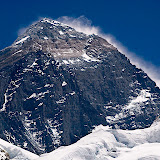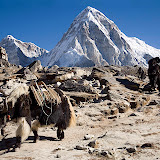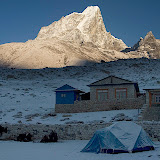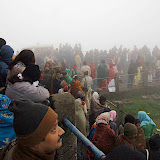Tuesday, April 22, 2008
Apr 26 - 28; Lobuche, EBC, Gorak Shep, Dingboche, Island Base Camp
Saturday, April 19, 2008
Apr 22 - 25, Benkar, Namche, Deboche, Periche, Lobuche
We cross many steel cable suspension bridges as we hike to Namche Bazaar, a famous Sherpa village, the last big town before Everest Base Camp. The trail climbs 2000 feet in the last mile before the town. There is a lookout on the trail from which you can see Everest (and is my first glimpse of Everest here in Nepal). We also walk past piles of Mani Stones, which have prayers carved on them. The trail typically splits and passes on both sides of the Mani Stone piles. Buddhists always walk past the stones on the left (ie, keeping the stones to their right).
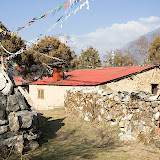 |
| Benkar to Lobuche |
I meet a journalist here who is following the Chinese attempt to take the Olympic torch up to the top of Everest. According to this journalist, the Chinese are carrying the torch up Everest from the Tibet side, then they will carry it down the same way. They are paranoid that someone will get to the top of Everest and protest the way the Chinese have been handling things in Tibet, thus screwing up what is sure to be good footage for their Olympic run-up. The Chinese made a "soft" loan (whatever that means) to Nepal and in return, Nepal is cracking down on protesters, even when peaceful. They have stated that no satellite phones are allowed on the Nepal side of the mountain until the torch is safely down. They have also banned cameras from all the Everest expeditions.
I have no idea if this is all true, but will ask around when I'm at the base camp and try to find out the facts (and report them here, not quite live, that is, about a week after the info is current).
The trail from Pheriche to Thokla goes down the center of a broad valley, with mountains on either side. After Thokla, we gain altitude and cross the Thokla pass at 16,000 feet. This location is significant as memorials to the climbers and Sherpas who have perished on Everest are erected here. It is a sobering experience because of the sheer number of cairns (50-ish).
April 19 - 21, Kathmandu, Lukla, Benkar
Arrive Kathmandu after spending the night in Delhi. The previous day was spent on planes from San Francsico to Delhi. I took some ambian, a drug to help you sleep, and slept for about 7 hours. This is a first folks! I will be a repeat customer.
I have a window seat on the north side of the plan from Delhi to Kathmandu which gives me a great view of the Himalaya in northern India and eastern Nepal. I see Machupachare and Annapurna just before landing in Kathmandu.
Khum Subedi, one of the principals of Unique Adventures, the trekking company I have signed up, puts a beautiful (but smelly) flower wreath over my head upon arrival. It's nice to be greeted, I'm able to brush off all the taxi drivers pestering me. The Australians I was to trek/climb with have bagged their trip and I re-evaluate my plans. Decide to do the Everest Base Camp trek followed by Island Peak climb. Previous plan was to climb Mera Peak but in reviewing a detailed map here in Kathmandu, the views will be much better from Island Peak, and doing both peaks is prohibitively expensive.
I spend some time talking to Khum about the recent Maoist election win in Nepal. He says he was surprised at the result, but Nepal needs a change and he is optimistic that things will improve. His fear is that the maoists tend to be poorly educated and will struggle initially with a lot of the government infrastructure already in place. Khum acknowledges that the government has been plagued with corruption and that the populace needs to be better educted to have a chance to reduce the corruption. Khum is also worried about the reception the rest of the world will give the new Maoist government. If the US and other countries reduce their already small investments in Nepal, it will hurt the country.
I thought the air was full of goo in Delhi but Kathmandu is much worse. It makes for a nice red ball sunset but aside from that, I want to escape to the mountains (I'm assuming they will be relatively clear).
The couple in the room next door are Kathmandu regulars (4 weeks per year) and suggest I walk three blocks down the street to the Kathmandu Guest House for dinner. They think it would be a smooth intro to Kathmandu for me. I concur, heading down the street and immediately get horribly lost. Being male, I use dead reckoning with stoicism to get further and further from my goal. After thirty minutes I capitulate and decide to employ a strategy that worked in India, asking school age children for directions. Immediately, a small group of young children approach me and speak a few words of English to me. They jabber amongst themselves and when I repeat my question of, "Where is Thamel?" (Thamel is the tourist part of the city is likely the best known quarter in the city.) They fix me with blank stares and babble some words in Nepali. I repeat a similar exercise several times and determine I need to modify my plan.
Plan B - I seek out a chemist shop (pharmacy in the US). I figure that many of the drugs have English names and the "chemists" are likely better educated than most Nepalis. I hit pay dirt. He points me up a hill and says go left. I hurry along as I'm getting hungry. I see another tourist consulting a map and approach with my best, "Are you lost too?"
"No", he replies, "Just looking for a restaurant."
"Can you please point me to Thamel?"
Soon I'm at the Kathmandu Guest House restaurant sipping a margarita (hey, this place is pretty civilized! I had a hard time finding margies in India), and enjoying tandoori chicken. Predictably, I get lost on the way back to hotel and this time use my new strategy to quickly find my way.
---------------------------------------------
Sunday, April 20 - Kathmandu
Khum introduces me to the guide who is to lead my trek and climb. I get concerned when they ask me if I brought a rope, snow pickets and ice screws. I relate to Khum that I asked him repeatedly for a gear list and the short list that he returned had no such gear. Frankly, I'm stunned that a climbing outfit would not have a supply of this stuff and I tell him so. He backpedals and says he will provide this gear. He tells me of other trips that Lall, my guide, has lead up Everest, Pumori, Ama Dablam, Dahlagiri and other gnarly mountains. It emerges that each of these big expeditions brought all their own gear. Slowly he restores my confidence but I will reserve judgement until I see Lall in action on the mountain. (Lal turned out to be a very good guide who speaks pretty good English and ensured that I had a good time.)
Khum takes me to lunch. It is obvious that he is concerned that I am unhappy and he very much wants to make sure I am happy. I am happy, just concerned that Khum's company seems flaky compared to US standards. I vow to work with Khum to put in place a proper check list that he can send out to clients and avoid these misunderstandings in the future.
Kathmandu has rotating power outages to conserve energy. They don't have enough energy for the whole country to be on the grid at same time. I go with the flow and update my blog on the computer as power permits.
--------------------------
Monday April 21 - KTH to Lukla to Benkar
Flying from Kathmandu to Lukla is like nothing I've ever seen. When landing, you come in way high and then drop like a stone at the last minute. The airstrip is about 1000 feet long so there is no margin for error. It rises with an 8% grade which helps to slow planes. To take off, the planes fly down the runway in the opposite direction. One direction to land, the opposite direction for take off, regardless of wind. Oh, and the chances of doing a go-around are very low, you must nail the landing on the first try. Quite an experience.
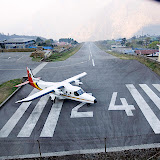 |
| Lukla |
Lal hires a porter to carry, "The Mother of God", my big Jansport wheeled bag. It contains my plastic climbing boots, ice axe, crampons, a bunch of camping gear like sleeping bag and pad, as well as extra clothes. I think it is enormous (hence the name), but when I look at some of the loads the porters carry, I realize it's no big deal for them.
We hike for 3 or 4 hours before stopping in Benkar for the night. It is common for trekkers to feel that each day is wimpy, but the stopping point each day is dictated not by how many hours you hike, but by elevation gain. They recommend that you limit elevation gain to 1500 feet per day. Most of the dwellings along the trail are constructed of stone. It is the most readily available building material, even though it takes longer to build a stone house than a house from wood.
Watching the Nepalese build a house or lodge is quite something. The first step is for porters to carry baskets containing as many rocks as they can carry (usually about 220 pounds) and deposit these rocks at the job site. The rocks will typically have dimensions between 6 and 18 inches and are irregular in shape. Two groups set to work on this large pile of rocks, one group reduces the rocks down to 1 inch in size to be used in making concrete. The other, more skilled group, uses hammer and chisel to create rectangular blocks. After some of these blocks have accumulated, a yet more skilled group of laborers join the team and fashion walls from the blocks.
In one location I see men with a large sledge hammer breaking up a 10 foot piece of bedrock that is located where they want the basement to be. It is amazing to see what can be done with primitive tools if you have time and manpower at your disposal. The dwellings look great when they are completed.
The locals seem more reserved and talk less than the people I encountered in India. The tourist density is higher along the main trekking corridor and the locals are likely more jaded here.
April 15, US Citizenship Day (well, at least for me)
Wake up about 3:30AM. Can't sleep. Finish extracting all my trip pictures to date and putting them onto my home computer. Take last look at immigration questions befored heading off at 6:15AM. Homeland Security Office is loced in south San Jose and I am to meet my attorney at 7AM prior to a 7:25 appointment. I arrive 20 mins early. It is really cold (60 degrees - back less than a week and I've become soft like most Californians) and the coffee shop owner, who is set up outside, moves a table and chair inside for me. He asks whether I am waiting for Richard and it turns out that Richard handled his immigration case. Coffee-guy says Richard is very good and his cases breeze through.
My inspector is sick and they hastily find an officer from a different branch to fill in. He is apolegetic and my attorney knows this officer quite well. It makes for a quick interview, especially as he can see that I speak English, uhh, somewhat decently (although he is still required to see me write a sentance, probably so they have some written record of my having passed a written English test. A key part of the test is when they hand me a page with 10 written questions about US Government. My questions are easy, the hardest one being "Who said the words, "Give me Liberty or give me death." (Patrick Henry) I confess that I did not know the answer until going through the 100 questions prior to the exam and seeing the answer. Having all the questions available ahead of time makes it easy for people like me that are good at rembering a bunch of facts for a short period of time.
They will schedule a "swearing In" ceremony for me sometime after I am back in the US, June 2. I found it anticlimactic to be through this phase of the immigration process. I'm not sure exactly what I was expecting, perhaps I wanted to see the wizard behind the curtain???? In any case, I felt happy and a bit smug and finally treated myself to a moca at the end of the day.
April 13, Mt Hood
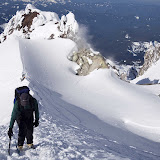 |
| Mt. Hood |
April 13 - Mt Hood
A brief note on the therapy that Dunkley and I employ. We have each found that climbing/hiking in the back country provides a healthy release of pent up frustrations, while providings some great conditioning. Dunkley has climbed Mt Hood (11,249 ft) more than 75 times in his life. Very few people have bettered his record of one hour forty-five minutes from the Timberline parking lot (6,000 ft) to the summit. I had never climbed Hood and it was a natural place to test out my new plastic boots. We leave the parking lot at 4AM and reach the summit about 10AM, a leisurely jaunt on a beautiful day, almost cloudless till we reach the summit when a weather system starts to blow in. My boots do fine and aside from a brief "moment" at the top, I do fine.
The normal summit approach to Hood is up a feature called the Hog's Back and then to the right and up a steep snow slope through "The Pearly Gates". The gates are covered in bulbous ice rime pearls up to 12 inches in diameter. The picture makes the name obvious. However, a steep ice ridge has blocked the path up through the Pearly Gates and the trail now heads west and then up an alternate steep snow slope. My "moment" comes as we traverse the ridge to the summit and make our way to the summit. We come to a section that is 12 inches wide and 8 feet long. On the north side of this narrow bridge is a 1000 foot sheer drop. I mean, you have zero chance of survival if you fall that way. On the south side the slope is only 75 degrees and there are obstructions (seracs) between 50 and 100 feet below. If you fell to this side and immediately did a proper and effective self arrest with your ice axe, you would stop in a few feet and could easily regain the the ridge. If you failed to arrest your rapid slide down the south side, you would become a large pinball, crashing into the seracs between 50 and 100 feet below. You would be battered but likely survive. I'm ahead of Dunkley and as I approach, I think of the line from Indiana Jones and The Last Crusade. "Ask Yourself, In What Do You Believe?". My memory is a bit fuzzy, but I think this is Walter Donovan talking to Jones immediately after shooting the older Dr. Jones. The connection for me is, "Do I believe in myself?". I drop to hands and knees and am across in less than 5 seconds, breathing a huge sigh of relief. And yes, my palms are sweating as I write this!
The view from the summit is good but there is a bit of crud in the air preventing the view from being stellar. To the north we see St Helens, Rainier and Adams. To the south, Jefferson is most prominent with Bachelor just visible through the goo. Winds are about 40mph (added bonus while crossing my favorite 8 ft section of real estate) and still mostly sunny, although with the wind we start to chill after 30 minutes and head back along the ridge. I reach my little bridge and spend a few seconds contemplating my navel before Dunkley arrives and says, "Dave, this is the the crux right here (Duhhhh Dunkley, what planet do think I'm from??) And it's best not to sit and comtemplate, just walk over, like this....." I sigh, step gingerly over this section and in 3 seconds am back on the "relatively" secure portion of the ridge. After I'm safely over, Dunk tells me that next time I should have the ice axe in my other hand (the one facing the survivable slope). It makes it more likely that if I do fall, I will fall in the "good" direction. I learn something new on all these expeditions.
April 8, Back in the US, Back in the US, Back in the US of A....
---------------------------------
Apr 8 - meet Ramona for lunch. Ramona lives in Delhi and we met at the Cherrepungee Resort. She and her good bud, Micheline, love to go on unusual trekking adventures. After lunch Ramona takes me to several spots which are popular with visitors to Delhi. I did not think I would buy anything but ended up getting several shirts, and a few small presents for freinds & family. The Khan Market is one the places we visit. It started out many years ago as a collection of shops that catered to the western crowd. As India's appetite grew for things that appeal to western taste, Khan Market has flourished. Ramona says Saturday morning the place is packed with half the expats in Delhi shopping here. It is only moderately crowded today, a Tuesday, with a mixture of local Indians (65%), teenage Indians (20%, love the coffee shops), foreign expats (10%) and tourists (5%). It is sufficiently crowded that parking is a challenge. Ramona finds a likely area with cars parked 2 or 3 deep and waits till a young "parking attendant" shows up (abt 10 seconds). We get out, hand the keys to the attendent, and walk off. He and his buddies will find a spot in the sea of cars, often shuffling the cars around, using the fact that they are all parked in neutral and can be pushed around. It reminds me of the small games I played as a child, where 15 or 24 small plastic tiles are arranged in a square grid on a plastic holder. The tiles can slide up, down or to the side. There is always one free opening and the trick is to slide the opening around such that the other tiles are left in place leaving a message or picture. This is just on a bigger scale.
Next stop is a government market established for artisans to sell their work directly to the public. This is good for buyers since it collects a lot of good handicrafts in one place, it allows you to bargain by playing artisan's off one another, and it's good for the artisans because there are no middlemen to skim the profits. It also makes for a more pleasant customer experience, for the artisans are not the professional, slick, huckster type sales people as found in Varanasi. It is 6PM when we've seen enough and I bid Ramona adieu, taking an auto-rickshaw back to the hotel to collect my bags and then giving the auto driver a bonus by having take me to the airport.
The flight, well, lets just say it was a long, long night with many trials along the way. I tried as much as possible to employ the techniques learned from the various books read over the past few months, maintaining a cheerful demeanor throughout. I know some of the airline employees and customs officials appreciated it, and it cost me nothing to remain calm and cheerful!
April 8 - California.
My plane left Delhi at 2AM and I arrived back at SFO at 2:30PM. Just in time for a 4PM dentist appt. Part of a crown fractured off a rear molar while eating dirt laden vegetables on the Goechela trek. I arranged the appointment a week in advance, giving myself what I thought would be some margin. My margin turned out to be marginal but sufficient. Fortunately the crown retained its seal and my dentist was able to do a bit of buffing and send me on my way again. The real repair happens in June when I have more time.
My time in the US is split between
- studying the immigration questions I will be asked during my US citizenship interview
- shopping for stuff that I will use on the remainder of my travels. Near the top of the list is what Jamie calls her, "Mother of God" duffle. It's the largest gear duffle I can find and ITS ON WHEELS! The other key item is a pair of plastic climbing boots.
- a quick trip to Portland to visit Jocelyn and wish her good luck with her final month of studies as well as visiting my good friend Gary Dunkley. Gary had not had many visitors of late and it was good both of us to connect.
- oh yes, the last thing I do while in the US is make sure all my pictures are backed up on my home machine. I won't bore you with details but the failure of my traveling laptop made it extremely painful (and time consuming) to do this backup.
Thursday, April 10, 2008
April 3, Darjeeling
--------------------------------------------------
Mar 31 - Apr 2 - Thapa Dara Busti
When we reach the Singshore Bridge, imagine my surprise to find a 14 year old suspension bridge which has been recently de-commissioned because the bridge engineer will no longer certify it for vehicle traffic. I'm flabbergasted at the shoddy result my engineering brethren have created and tell Bhim and his friends that the responsible engineer ought to be publicly humiliated to make an example for other Indian engineers. Despite my feelings for the engineer, I join Bhim, Sam and Barney as they spit over the side of the bridge and watch the tiny blobs disappear from view. Funny how this seems to have such universal appeal, like laughing when someone farts.
